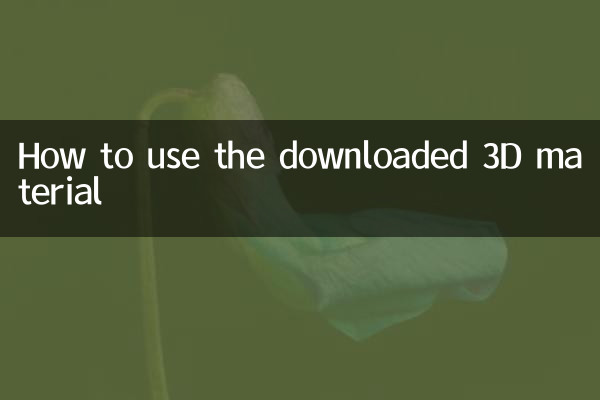How to use downloaded 3D materials
In 3D design and modeling, materials are key elements that give models realism and detail. Many designers download ready-made 3D materials from the Internet to improve work efficiency. This article will introduce in detail how to download and use 3D materials to help beginners get started quickly.
1. Download sources of 3D materials

The following are the popular 3D material download websites in the past 10 days and their characteristics:
| Website name | Features | Popular material types |
|---|---|---|
| Texture Haven | Free HD textures, supports PBR | Stone, metal, wood |
| Poliigon | High quality paid material library | Construction and industrial materials |
| CC0 Textures | CC0 agreement, available for commercial use | natural textures, fabrics |
| Quixel Megascans | Film and television grade material library | terrain, vegetation |
2. Steps for using 3D materials
The following is a general process for using downloaded 3D materials:
| step | Operating Instructions |
|---|---|
| 1. Import materials | Import the downloaded material files (such as .jpg/.png/.tif) into the 3D software |
| 2. Create a shader ball | Create a new shader in the material editor |
| 3. Connect the map | Connect diffuse reflection, normal, roughness and other maps to the corresponding channels |
| 4. Adjust parameters | Adjust parameters such as reflectivity and metallicity according to rendering needs |
| 5. Apply materials | Assign materials to the model and perform test rendering |
3. Frequently Asked Questions
Q: What should I do if the downloaded materials are not displayed correctly?
A: First check whether the texture path is correct, and secondly confirm whether the renderer supports the material format. PBR materials need to ensure that all channel maps are complete.
Q: How to customize material effects?
A: You can overlay multiple layers of textures in the material editor, or mix different materials through masks. Professional software such as Substance Designer allows in-depth editing of materials.
4. Tips on using 3D materials
1.UV expansion is important: Ensure that the model has a reasonable UV layout to avoid material stretching.
2.Use material library management: It is recommended to use tools such as Bridge to uniformly manage material assets.
3.Pay attention to file format: EXR format is suitable for HDR workflow, JPG is suitable for quick preview.
4.Mixed materials: Achieve natural transitions between different materials through the vertex drawing function.
5. Popular 3D material trends
According to recent data analysis, the demand for the following material types has increased significantly:
| Material category | growth rate | Application scenarios |
|---|---|---|
| Nanomaterials | +42% | Electronic product rendering |
| biological material | +35% | Game character design |
| traces of destruction | +28% | Film and television special effects |
| Luminous material | +25% | science fiction scene |
Mastering the skills of using 3D materials can significantly improve the quality of your work. It is recommended that novices start practicing with basic materials and gradually master the PBR workflow. As you accumulate experience, you can also try to create your own material library to improve work efficiency.

check the details

check the details